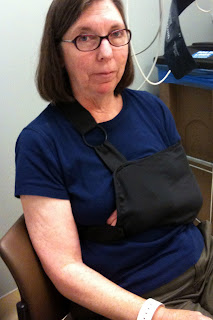 |
| Lifted from FB, photo taken at "1/8000 sec" Wow! |
A millisecond is 1/1000th of a second. The light from a typical photo flash strobe lasts a millisecond. The average human blink lasts 3/10ths of a second (or 300 milliseconds). So the balloon shape of the water lasts wa-a-a-a-y less than the blink of an eye, once the balloon is popped.
How quickly things can change.
For instance: There you go, running an agility course with your dog. The fastest time wins. The electronic timer is keeping track, down to 1/100ths of a second. Your dog is keeping track of your body language, which is constantly changing as you make your way through the course. Well-trained dogs look for specific changes in your body language (cues), and experienced dogs look for the First Indicator of each of those cues. Do you know exactly what your dog is looking for?
I've heard people say "That dog can read my mind!" Heck, I've even said it, after a particularly smooth and speedy run, because I had no idea what I did to cue my dog, in certain areas...
It could be that my dog just saw a First Indicator - that one movement that he's noticed always happens in the instant before I give a certain cue. A slight rise of the shoulder? An imperceptible shift of weight? An elbow angle? A head tilt? So he took the correct obstacle...and shazam! - in the blink of an eye - he could read my mind....
How do they do that?? As I understand it, the eyesight capability of dogs is less than that of humans...so they stand even less of a chance than we do of seeing water hold a balloon shape after a water balloon is popped. (Like, no chance x thousands.)
Still, they have a big advantage over us because of their amazing abilities to FOCUS and to PAY ATTENTION.....ALL THE TIME.
We shouldn't need fancy cameras to figure out what our dogs are reading as First Indicators when we give certain cues. We just need to video our runs, then study the videos. Decide what it is. Then run each cue consistently. [Heh heh.] This is what some trainers like the Derretts have done, prior to generalizing their methods into training-classes-for-the-masses.
Could finding your own First Indicators be similar to the time and equipment needed to train a dog for running contacts (via Silvia Trkman's method)? Every dog and handler team is different...so it seems you'd want to see exactly what's happening during each repetition. Then you'll want to find the best cues (timers help, since the best is the fastest, in the long run). Then practice your cue, and your dog's reaction, in a variety of situations.....different fields, different equipment, and even different weather conditions. (To say nothing of the mood and health changes that both dog and handler go through...) So you'd need to work a fair number of obstacles, and video a lot of it, then carefully study all the film....
And consistently work at being consistent. [But not boring...] And record your findings in an organized way, because there will be way more information than you could remember....
and....and....
Does this sound like a thesis project for someone in grad school?!
[Sigh.]
Okay. Maybe I'm making too much of an instinctive action-reaction that naturally develops during dog training. [Do I have too much thinking time, these days?] Maybe we don't need to develop such a fine-toothed comb. We are human, after all. And our dogs are dogs. We're just trying to have a good time. (Although - YES, I totally admit it - we're also trying to WIN....which is why we study....)
But, honestly.....when I'm running a course? I mostly just bumble along, doing the best I can, with whatever gifts the smiling-gods-above have given me that day. I can't always pin-point those gifts, and I don't always try to. I like to think my agility family completely understands.



























